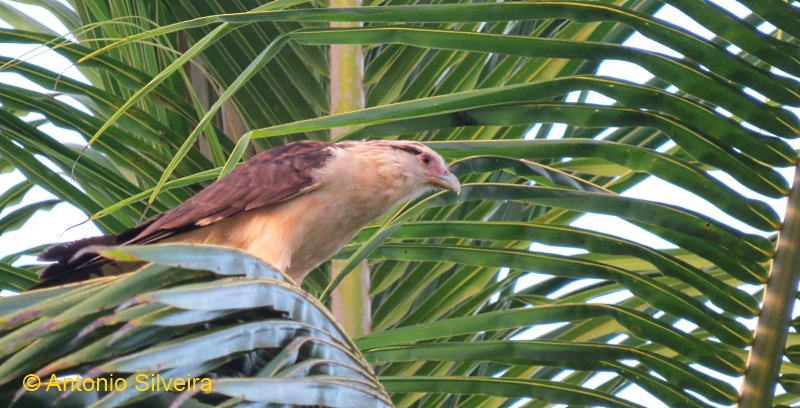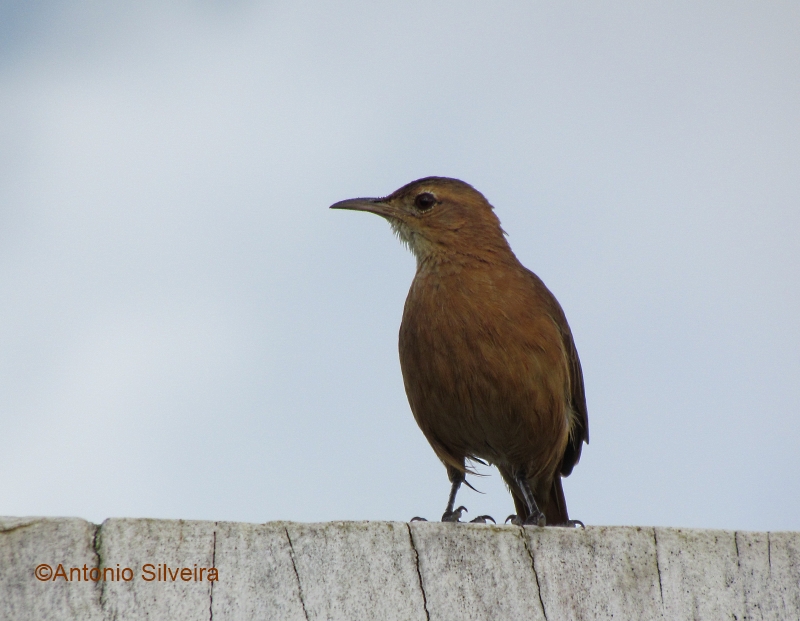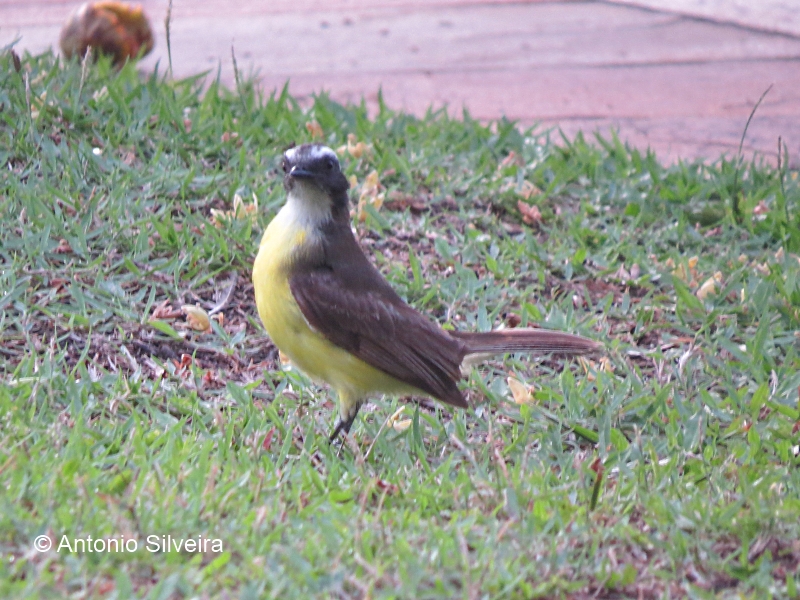Aves da Ilha de Comandatuba (Una-BA) (Birds of Comandatuba Island -Una-BA, Brazil)
A Ilha de Comandatuba, com cerca de 22 km de praia, fica na região sul da Bahia, nos municípios de Canavieiras e Una, ficando praticamente toda neste último.
Apesar da interferência antrópica, com plantações centenárias de coco, ainda mantém trechos de manguezal, de restinga e de alagados, onde existem muitas espécies de aves.
Desenvolvendo projeto de levantamento da avifauna da citada ilha, estivemos (Antonio Silveira) no local, entre 5 e 15 de fevereiro de 2004, hospedados no Hotel Transamérica – Ilha de Comandatuba, para orientação e reestruturação do birding no hotel, o que resultou na época uma listagem preliminar das aves observadas na ilha (totalizando 85 espécies).
Na área do citado hotel há uma interessante passarela de madeira de cerca de 100 metros sobre o mangue, onde é possível avistar a fauna deste ambiente, principalmente os Savacu-de-coroa (Nyctanassa violacea, Yellow-crowned Night-Heron) que faz ninhos no local, chegando, segundo o biólogo local Maurício Arantes, a ter 39 ninhos ativos. Também é fácil ver e ouvir o Xexéu (Cacicus cela; Yellow rumped Cacique). Da passarela é possível avistar também as várias espécies de caranguejos e siris, além de bandos do Sagüi (Callithryx kuhlii, marmoset), endêmico desta região da Bahia, que veme ao mangue para se alimentar do caranguejo-marinheiro espécie arborícola que vive nas árvores do mangue.
Um local também muito interessante para observar aves é o campo de golfe do hotel, pois possui uma área muito grande com lagos e matas de restinga entre os buracos, onde é possível observar aves interessantes como o pequeno rallideo Sanã-castanha (Laterallus viridis; Russet-crowned Crake), o Iraúna-grande (Molothrus oryzivorus; Giant Cowbird) e aves migratórias como maçaricos, que param nos gramados e lagos. Muitas vezes percorremos o campo de golfe em carrinhos elétricos, que além de silenciosos são práticos, tornando a observação mais cômoda e fácil.
Retornamos a esta ilha espetacular em novembro de 2004, janeiro de 2007, janeiro de 2009, janeiro de 2010, janeiro e outubro de 2011, março 2012, janeiro 2013 e outubro de 2013, onde temos feito horas agradáveis de observação de aves, atualizando a lista para 137 espécies.
—————-
The Comandatuba Island, about 22 km of beach, is in the southern region of Bahia, in the municipalities of Una and Canavieiras, getting nearly all the latter.
Despite the anthropogenic interference with coconut plantations centuries, still retains patches of mangrove, salt marsh and wetlands, where there are many species of birds.
Developing project survey of the avifauna of that island, were (Antonio Silveira) on site between 5 and 15 February 2004, staying at the Hotel Transamerica – Comandatuba Island, for advice and restructuring of birding in the hotel, which resulted in time a preliminary list of birds observed on the island (a total of 85 species).
In the area of the hotel said there is an interesting wooden walkway about 100 feet above the mangrove, where it is possible to see the fauna of this environment, especially the crown-of-Savacu (Nyctanassa violacea, Yellow-crowned Night-Heron) making nests site, reaching, according to local biologist Mauricio Arantes, to have 39 active nests. It is also easy to see and hear the Xexéu (Cacicus cela; Yellow rumped Cacique). The walkway is also possible to see several species of crabs and crabs, as well as troops of marmoset (Callithryx kuhlii), endemic to this region of Bahia, which came to mangrove eating for crab-sailor, an arboreal species living in the mangrove trees.
A place also very interesting to observe birds is the golf course the hotel because it has a very large area with lakes and forests sandbank between the holes where you can see interesting birds like the rallidae Russet -crowned Crake (Laterallus viridis), the Giant Cowbird (Molothrus oryzivorus) and migratory birds such as kingfishers, stopping on the lawns and lakes. Many times we go through the golf course in electric cars, which are practical as well as silent, making the observation more comfortable and easy.
We return to this spectacular island in November 2004, January 2007, January 2009, January 2010, January and October 2011 , March 2012, January 2013 and October 2013, where we have done such a good time for bird watching, updating the list to 137 species.
Lista preliminar e cumulativa das aves da Ilha de Comandatuba-Una-BA (Preliminary list of birds and cumulative Island Comandatuba-Una-BA) por (by) Antonio Silveira (colaboração de -collaboration of Maurício A.Oliveira)
ANATIDAE
Amazonetta brasiliensis; Pé-vermelho; Brazilian Teal
FREGATIDAE
Fregata magnificens; Tesourão; Magnificent Frigatebird
PHALACROCORACIDAE
Phalacrocorax brasilianus; Biguá; Neotropic Cormorant (abaixo-below)
ARDEIDAE
Botaurus pinnatus; Socó-boi-baio; Pinnated Bittern (abaixo-below) ***
Nycticorax nycticorax; Savacu; Black-crowned Night-Heron (abaixo-below)
Nyctanassa violacea; Savacu-de-coroa; Yellow-crowned Night-Heron (abaixo-below) (VOZ-VOICE)
Butorides striata; Socozinho; Striated Heron (abaixo-below)
Bulbucus ibis; Garça-vaqueira; Cattle Egret
Ardea cocoi; Garça-moura; Cocoi Heron (abaixo-below)
Ardea alba; Garça-branca-grande; Great Egret
Egretta thula; Garça-branca-pequena; Snowy Egret (abaixo-below)
Egretta caerulea; Garça-azul; Little Blue Heron (abaixo-below)
CATHARTIDAE
Cathartes aura; Urubu-de-cabeça-vermelha; Turkey Vulture (abaixo-below)
Cathartes burrovianus; Urubu-de-cabeça-amarela;Lesser Yellow-headed Vulture
Coragyps atratus; Urubu-de-cabeça-preta; Black Vulture (abaixo-below)
ACCIPITRIDAE
Gampsonyx swainsonii; Gaviãozinho; Pearl Kite
Circus buffoni; Gavião-do-banhado; Long-winged Harrier (1) (abaixo-below)
Urubitinga urubitinga; Gavião-preto; Great Black Hawk *
Rupornis magnirostris; Gavião-carijó; Roadside Hawk (abaixo-below)
Buteo nitidus; Gavião-pedrês; Gray Hawk *
FALCONIDAE
Caracara plancus; Caracara; Southern Caracara (abaixo-below)
Milvago chimachima; Carrapateiro; Yellow-Headed Caracara (abaixo-below) (VOZ-VOICE)
Herpetotheres cachinnans; Acauã; Laughing Falcon
Falco sparverius; Quiriquiri; American Kestrel *
Falco rufigularis; Cauré; Bat Falcon
Falco peregrinus; Falcão-peregrino; Peregrine Falcon *
RALLIDAE
Aramides mangle; Saracura-do-mangue; Little Wood-Rail (2) (abaixo-below) (VOZ-VOICE)
Aramides cajanea; Saracura-três-potes; Gray-necked Wood-Rail (abaixo-below)
Laterallus ( Anurolimnas) viridis; Sanã-castanha; Russet-crowned Crake (abaixo-below) (VOZ-VOICE)
CHARADRIIDAE
Vanellus cayanus; Batuíra-de-esporão; Pied Lapwing
Vanellus chilensis; Quero-quero; Southern Lapwing (abaixo-below)
Pluvialis squatarola; Batuíruçu-de axila-preta; Black-bellied Plover (abaixo-below)
Charadrius semipalmatus; Batuíra-de-bando; Semipalmated Plover
Charadrius wilsonia; Batuíra-bicuda; Wilson’s Plover (abaixo-below)
Charadrius collaris; Batuíra-de-coleira; Collared Plover (abaixo-below)
SCOLOPACIDAE
Numenius phaeopus; Maçarico-galego; Whimbrel
Actitis macularius; Maçarico-pintado; Spotted Sandpiper (abaixo-below)
Tringa solitaria; Maçarico-solitário; Solitary Sandpiper (abaixo-below)
Tringa flavipes; Maçarico-de-perna-amarela; Lesser Yellowlegs
Arenaria interpres; Vira-pedras; Ruddy Turnstone
Calidris alba; Maçarico-branco; Sanderling (abaixo-below)
Calidris pusilla; Maçarico-rateirinho; Semipalmated Sandpiper *
JACANIDAE
Jacana jacana; Jaçanã; Wattled Jacana
STERNIDAE
Sterna sp; Trinta-réis, Tern *
COLUMBIDAE
Columbina talpacoti; Rolinha-roxa; Ruddy Ground-Dove
Columbina squammata; Fogo-apagou; Scaled Dove (abaixo-below)
Patagioenas picazuro; Pombão; Picazuro Pigeon
Patagioenas cayennensis; Pomba-galega; Pale-vented Pigeon
Leptotila verreauxi; Juriti-pupu; White-tipped Dove
PSITTACIDAE
Aratinga aurea; Periquito-rei; Peach-fronted Parakeet (abaixo-below) (VOZ-VOICE)
Forpus xanthopterygius; Tuim; Blue-winged Parrotlet (VOZ-VOICE)
Amazona amazonica; Curica; Orange-winged Parrot
CUCULIDAE
Piaya cayana; Alma-de-gato; Squirrel Cuckoo
Crotophaga major; Anu-coroca; Greater Ani
Crotophaga ani; Anu-preto; Smooth-billed Ani (abaixo-below)
Guira guira; Anu-branco; Guira Cuckoo (abaixo-below) (VOZ-VOICE)
TYTONIDAE
Tyto alba; Coruja-da-igreja; Barn Owl
STRIGIDAE
Megascops choliba; Corujinha-do-mato; Tropical Screech-Owl
NYCTIBIIDAE
Nyctibius griseus; Mãe-da-lua; Commom Potoo (abaixo-below)

CAPRIMULGIDAE
Hydropsalis albicollis; Bacurau; Pauraque
TROCHILIDAE
Eupetomena macroura; Beija-flor-tesoura; Swallow-tailed Hummingbird (abaixo-below)
Chlorostilbon lucidus;Besourinho-de-bico-vermelho;Glittering-bellied Emerald *
Amazilia leucogaster; Beija-flor-de-barriga-branca; Plain-bellied Emerald
Amazilia versicolor; Beija-flor-de-banda-branca; Versicolored Emerald (abaixo-below)
Amazilia fimbriata; Beija-flor-de-garganta-verde; Glittering-throated Emerald
ALCEDINIDAE
Megaceryle torquata; Martim-pescador-grande; Ringed Kingfisher (abaixo-below) (VOZ-VOICE)
Chloroceryle amazona; Martim-pescador-verde; Amazon Kingfisher
Chloroceryle americana; Martim-pescador-pequeno; Green Kingfisher (abaixo-below)
PICIDAE
Melanerpes candidus; Birro; White Woodpecker
Colaptes melanochloros; Pica-pau-verde-barrado; Green-barred Woodpecker (abaixo-below)
Colaptes campestris; Pica-pau-do-campo; Campo Flicker (abaixo-below)
Dryocopus lineatus; Pica-pau-de-banda-branca; Lineated Woodpecker (abaixo-below) (VOZ-VOICE)
DENDROCOLAPTIDAE
Dendroplex picus; Arapaçu-de-bico-branco; Straight-billed Woodcreeper (abaixo-below) (VOZ-VOICE)
FURNARIIDAE
Furnarius figulus; Casaca-de-couro-da-lama; Wing-banded Hornero (abaixo-below) (VOZ-VOICE)
Furnarius rufus; João-de-barro; Rufous Hornero (abaixo-below)
Pseudoseisura cristata; Casaca-de-couro; Caatinga Cacholote (abaixo-below) (VOZ-VOICE)
Certhiaxis cinnamomeus; Curitiê; Yellow-chinned Spinetail (abaixo-below) (VOZ-VOICE)
Synallaxis frontalis; Petrim; Sooty-fronted Spinetail
RYNCHOCYCLIDAE
Todirostrum cinereum; Ferreirinho-relógio; Common Tody-Flycatcher
TYRANNIDAE
Elaenia flavogaster; Guaracava-de-barriga-amarela; Yellow-bellied Elaenia
Myiarchus ferox; Maria-cavaleira; Short-crested Flycatcher
Myiarchus tyrannulus; Maria-cavaleira-de-rabo-enferrujado; Brown-crested Flycatcher
Pitangus sulphuratus; Bem-te-vi; Great Kiskadee (abaixo-below)
Machetornis rixosa; Suiriri-cavaleiro; Cattle Tyrant (abaixo-below)
Myiodynastes maculatus; Bem-te-vi-rajado; Streaked Flycatcher
Megarynchus pitangua; Neinei; Boat-billed Flycatcher
Myiozetetes similis; Benteviznho-de-penacho-vermelho; Social Flycatcher (abaixo-below)
Tyrannus melancholicus; Suiriri; Tropical Kingbird (abaixo-below)
Empidonomus varius; Peitica; Variegated Flycatcher
Fluvicola nengeta; Lavadeira-mascarada; Masked Water-Tyrant (abaixo-below)
Arundinicola leucocephala; Freirinha; White-headed Marsh-Tyrant
VIREONIDAE
Cyclarhis gujanensis; Pitiguari; Rufous-browed Peppershrike (VOZ-VOICE)
Vireo olivaceus; Juruviara; Red-eyed Vireo
HIRUNDINIDAE
Pygochelidon cyanoleuca; Andorinha-pequena-de-casa; Blue-and-white Swallow (abaixo-below) (VOZ-VOICE)
Stelgidopteryx ruficollis; Andorinha-serradora; Southern Rough-winged Swallow
Progne tapera; Andorinha-do-campo; Brown-chested Martin
Progne subis; Andorinha-azul; Purple Martin
Progne chalybea; Andorinha-doméstica-grande; Gray-breasted Martin (abaixo-below)
Tachycineta albiventer; Andorinha-do-rio; White-winged Swallow (abaixo-below)
TROGLODYTIDAE
Troglodytes musculus; Corruíra; Southern House Wren (abaixo-below)
TURDIDAE
Turdus rufiventris; Sabiá-laranjeira; Rufous-bellied Thrush (abaixo-below) (VOZ-VOICE)
Turdus leucomelas; Sabiá-barranco; Pale-breasted Thrush (abaixo-below) (VOZ-VOICE)
Turdus amaurochalinus; Sabiá-poca; Creamy-bellied Thrush
MIMIDAE
Mimus gilvus; Sabiá-da-praia; Tropical Mockingbird (abaixo-below)
Mimus saturninus; Sabiá-do-campo; Chalk-browed Mockingbird (abaixo-below)
MOTACILLIDAE
Anthus lutescens; Caminheiro-zumbidor; Yellowish Pipit (abaixo-below)
COEREBIDAE
Coereba flaveola; Cambacica; Bananaquit
THRAUPIDAE
Ramphocelus bresilius; Tiê-sangue; Brazilian Tanager (abaixo-below) (VOZ-VOICE)
Ramphocelus carbo; Pipira-vermelha; Silver-beaked Tanager
Tangara mexicana; Saíra-de-bando; Turquoise Tanager *
Tangara sayaca; Sanhaçu-cinzento; Sayaca Tanager (abaixo-below)
Tangara palmarum; Sanhaçu-do-coqueiro; Palm Tanager
Tangara cayana; Saíra-amarela; Burnished-buff Tanager
Paroaria dominicana; Cardeal-do-nordeste; Red-cowled Cardinal (abaixo-below)
Dacnis cayana; Saí-azul; Blue Dacnes
Conirostrum speciosum; Figuinha-de-rabo-castanho; Chesnut-vented Conebill
Conirostrum bicolor; Figuinha-do-mangue; Bicolored Conebill (abaixo-below)
EMBERIZIDAE
Sicalis flaveola; Canário-da-terra-verdadeiro; Saffron Finch (abaixo-below) (VOZ-VOICE)
Sporophila nigricollis; Baiano; Yellow-billed Seedeater (abaixo-below) (VOZ-VOICE)
Sporophila caerulescens; Coleirinho; Double-collared Seedeater
Sporophila leucoptera; Chorão; White-bellied Seedeater
PARULIDAE
Parula pitiayumi; Mariquita; Tropical Parula
Geothlypis aequinoctialis; Pia-cobra; Market Yellowthroat
ICTERIDAE
Cacicus cela; Xexéu; Yellow rumped Cacique (abaixo-below) (VOZ-VOICE)
Icterus cayanensis; Encontro;Epaulet Oriole
Icterus jamacaii; Corrupião; Campo Troupial (VOZ-VOICE)
Gnorimopsar chopi; Graúna; Chopi Blackbird (VOZ-VOICE)
Pseudoleistes guirahuro; Chopim-do-brejo; Yellow-rumped Marshbird **
Molothrus bonariensis; Vira-bosta; Shiny Cowbird (abaixo-below)
Molothrus oryzivorus; Iraúna-grande; Giant Cowbird (abaixo-below)
FRINGILLIDAE
Euphonia chlorotica; Fim-fim; Purple-throated Euphonia
Euphonia violacea; Gaturamo-verdadeiro; Violaceous Euphonia *
PASSERIDAE
Passer domesticus; Pardal; House Sparrow (abaixo-below) (VOZ-VOICE)
—————
* espécies observadas exclusivamente pelo biólogo Maurício Arantes, residente na região.
(1) No dia 12 de outubro 2011, foi observadopor Antonio Silveira, Maurício Oliveira e Victor Chahin e fotografada por este último.
(2) espécie observada exclusivamente pelo biólogo Maurício Arantes, residente na região, até outubro de 2011.Nos disa 1o a 15 de outubro 2011, foi observada também por Antonio Silveira e filmada, fotografada e gravada vocalização.Inclusive com avistamento de cerca de 12 indivíduos próximo à passarela do mangue do citado hotel.
(2) Species only observed by the biologist Mauricio Arantes, resident in the region until October 2011, was also observed by Antonio Silveira and filmed, photographed and recorded vocalizations including sighting of about 12 individuals near the mangrove walkway of that hotel.
** observado bando de 4 ou 5 indivíduos. Talvez soltura, pois não é prevista distribuição para a região.
*** – reconfirmar (to confirm)
Agradecimentos: agradecemos ao pessoal e à diretoria do Hotel Transamérica Comandatuba, em especial ao diretor Thomas Humpert e o gerente Reimar Leme do Prado, pela atenção em nossas estadas e apoio nos trabalhos ornitológicas na região. Agradecemos ao biólogo Maurício Arantes pela companhia e colaboração nas nossas saídas à campo.
 Maurício A.Oliveira e Antonio Silveira
Maurício A.Oliveira e Antonio Silveira  Mangrove
Mangrove
Mauricio A.Oliveira e Antonio Silveira em observação de campo
Acknowledgments: We thank the staff of the Hotel Transamerica Comandatuba, especially the director Thomas Humpert , managers Hercules Travassos and Reimar Leme do Prado, for attention in our state and support in theornithological work in the region. We thank biologist Mauricio Arantes de Oliveira by the company and our collaboration inthe output field.
Obs: ordem sistemática de famílias, espécies e nomes conforme Comitê Brasileiro de Registros Ornitológicos (2011) Listas das aves do Brasil. Versão 25/01/2011, 10ª ed. (http://www.cbro.org.br).
Note: systematic order of families and species names as Brazilian Committee of Ornithological Records (2011) List o fbirds of Brazil. 25/01/2011 Version, 10th ed.(http://www.cbro.org.br).
————————————-
Registros documentados (documented records):
SANTOS, A.S.R. Predação do caranguejo marinheiro (Aratus pisonii) pelo Sagüi de Wied (Callithrix kuhlii) nos manguezais da Ilha de Comandatuba, Una, Bahia, Brasil. Publicação on line, www.aultimaarcadenoe.com.br – Fevereiro 2011 (ENGLISH VERSION)
SANTOS, Antonio Silveira R.; OLIVEIRA, Maurício A. Registro documentado da Saracura-do-mangue Aramides mangle (Spix,1825), (Aves, RALLIDAE) nos mangues da Ilha de Comandatuba, Una, Bahia, Brasil. Publicação on line, www.aultimaarcadenoe.com.br – outubro 2011.(AND ENGLISH VERSION)
SANTOS, Antonio Silveira R.; OLIVEIRA, Maurício A. CHAHIN,Victor. Registro documentado do Gavião-do-banhado Circus buffoni (Aves, ACCIPITRIDAE) na Ilha de Comandatuba, Una, Bahia, Brasil. Publicação on line-PDF, www.aultimaarcadenoe.com.br – outubro 2011. (AND ENGLISH VERSION)
————–
Acesse Sons da Natureza e Fauna do Brasil com sons e vídeos de algumas das espécies da região. (See the pages Sounds of Nature and Wildlife of Brazil with sounds and videos of some of the species in the region).
Or: videos, photos and songs of Birds of Comandatuba Island in: Antonio Silveira in THE INTERNET BIRD COLLECTION and our songs in XENO-CANTO
————
(translate to english by Antonio Silveira with help google translate on line)
(última atualização – Last upgrade 02/2/2016)



































































